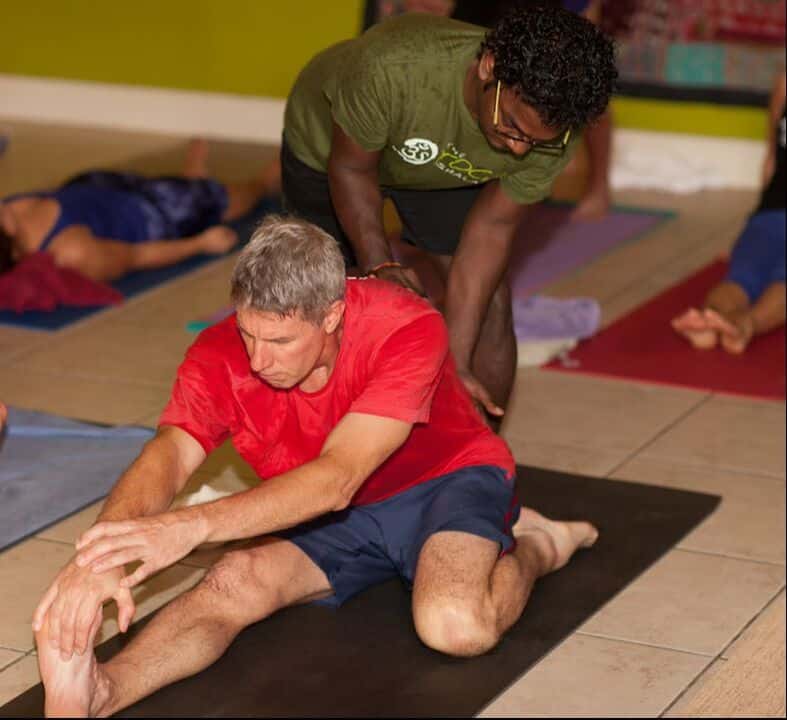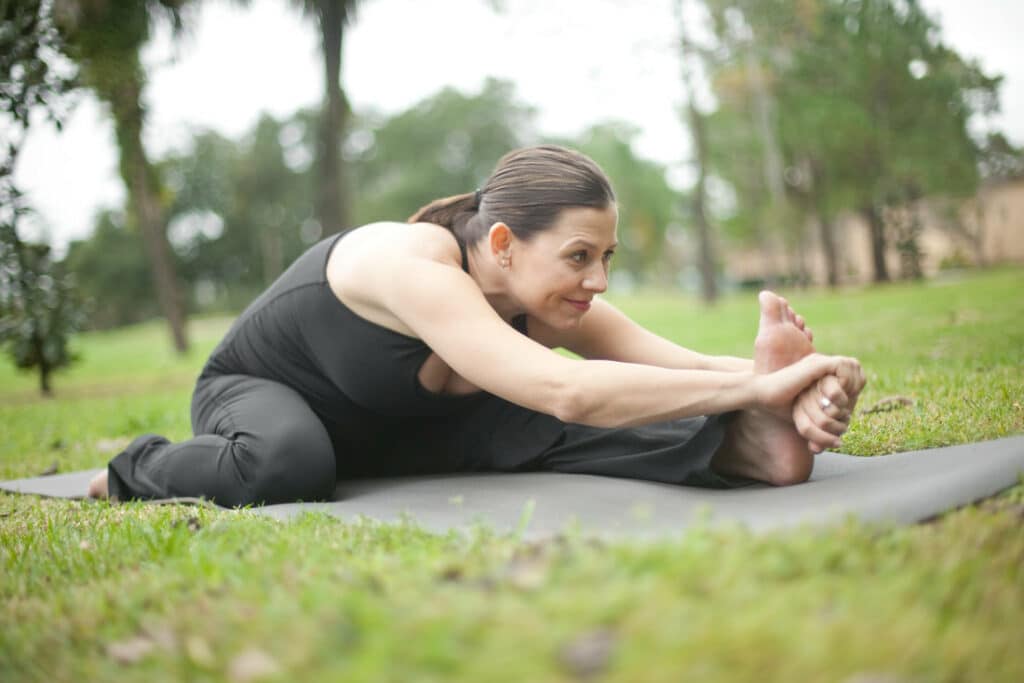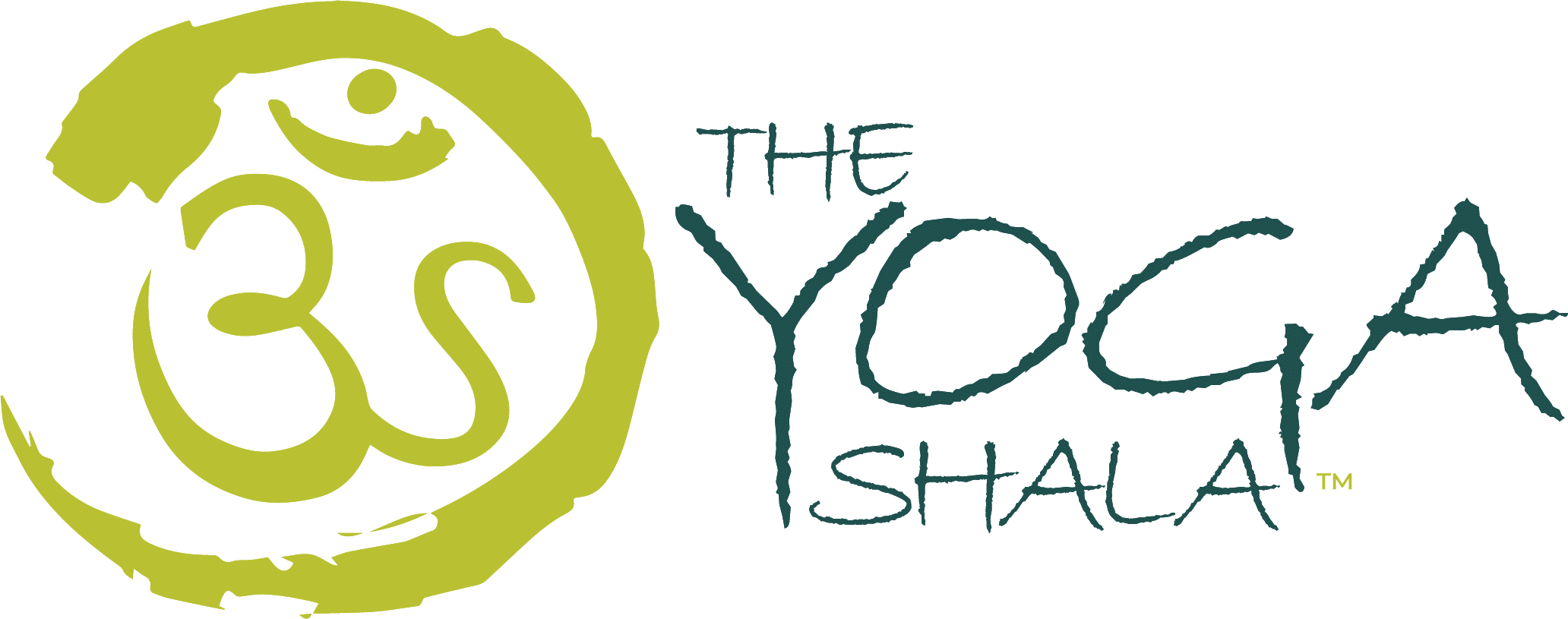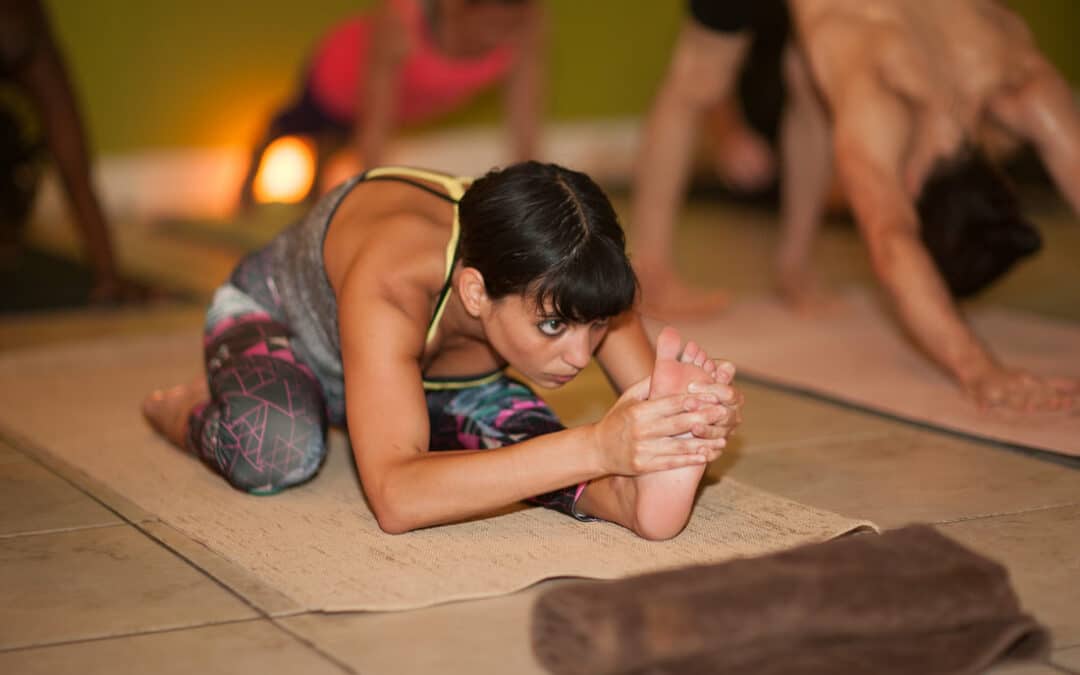Ashtanga Yoga, a dynamic and rigorous style of yoga, offers a sequence of postures that progressively challenge both the body and mind. Trianga Mukhaikapada Paschimottanasana, a mouthful to pronounce but a rewarding pose to master, is part of the Ashtanga Yoga Primary Series. In this blog post, we will delve into the nuances of this asana, its benefits, step-by-step instructions, modifications, and precautions.
Understanding Trianga Mukhaikapada Paschimottanasana:
Trianga Mukhaikapada Paschimottanasana, often abbreviated as Trianga Paschimottanasana, is a seated forward bend that involves an intense stretch of the hamstring and back muscles. The name itself provides insight into the pose:
- “Trianga” refers to three parts: the two legs and the head.
- “Mukha” means facing.
- “Eka” translates to one.
- “Pada” signifies leg.
- “Paschimottanasana” is a seated forward fold.
The combination of these components highlights the essence of the pose, where one leg faces forward while the other extends to the side, creating a triangular shape.
Benefits of Trianga Mukhaikapada Paschimottanasana
Hamstring Flexibility:
This asana deeply stretches the hamstrings, helping to increase flexibility and range of motion in the back of the thighs.
Spinal Mobility:
The forward bend promotes flexibility in the spine, especially the lumbar and thoracic regions, leading to improved posture and reduced back stiffness.
Hip Opening:
The extended leg position opens the hips and groin, providing relief from tightness and enhancing hip joint mobility.
Stress Relief:
The calming effect of forward bends like Trianga Paschimottanasana soothes the nervous system, promoting relaxation and reducing stress and anxiety.
Digestive Stimulation:
The compression of the abdomen massages the digestive organs, aiding digestion and promoting healthy bowel movements.
Circulation:
The pose improves blood flow to the pelvic region, helping to alleviate menstrual discomfort and support reproductive health.
Mindfulness:
Practicing this pose requires concentration and awareness of the body, cultivating mindfulness and mental clarity.
Calming the Mind:
The inward focus encouraged during this pose can have a meditative quality, promoting a sense of calmness and tranquility.

Click here to watch the YouTube tutorial for Trianga Mukhaikapada Paschimottanasana
Contraindications and Precautions:
Back Injuries:
Individuals with lower back injuries or conditions like herniated discs should approach this pose cautiously. It’s important to maintain a neutral spine and avoid excessive rounding.
Hamstring Injuries:
If you have acute hamstring injuries, approach the pose with care and avoid overstretching the injured area.
Knee Issues:
Individuals with knee problems, especially in the bent knee, should modify this posture to support the knee and avoid excessive strain.
Pregnancy:
Pregnant individuals should modify the pose by widening the legs slightly to accommodate the growing belly. It’s advisable to consult a prenatal yoga instructor or healthcare provider before attempting this pose.
High Blood Pressure:
Those with high blood pressure should avoid holding the pose for extended periods and can consider modifications.
Insomnia:
If you have insomnia or other sleep disorders, avoid practicing this pose close to bedtime, as it can be stimulating for some individuals.
Osteoporosis:
Individuals with osteoporosis should avoid deep forward bends that could strain the spine. Modifying the pose with props or under the guidance of a qualified instructor is recommended.
Neck Issues:
If you experience neck discomfort or tension, keep your gaze slightly forward rather than looking down to avoid strain on the neck.

Click here to watch the YouTube tutorial for Trianga Mukhaikapada Paschimottanasana
Step by Step Instructions for Trianga Mukhaikapada Paschimottanasana with Sanskrit Vinyasa Count
We will be entering this posture from downward facing dog, having just taken a vinyasa after Ardha Baddha Padma Paschimottanasana to seated position.
Sapta (Vinyasa #7): From Adho Mukha Svanasana (down dog), look forward and walk or jump your feet through and have a seat on the floor with your legs extended in front of you (or for more advanced version, jump through with your right leg bent backwards and your left leg extended straight out in front of you.
Inhale, bend your right knee backwards so the top of your right foot is pressing into the ground. Try to ground through both sits bones. Stretch both arms forward and grab your left foot with both hands. Left foot is flexed. Head up.
Asthau (Vinyasa #8) Exhale and fold forward out over your straight left leg. Be sure you maintain flexion in your left foot, engage the left quadricep and press your heel forward as you press your tailbone backward. Bring your chin to your chin if you can. Look towards your toes (Padhayoragrai drishti). Breathe here for five deep breaths. With each inhale, elongate your spine, lifting your chest slightly.
Adjustments and Alignment Tips:
-
- Keep both sitting bones grounded to maintain balance.
- Flex your left foot actively to engage the muscles and protect the knee.
- Continuously press the top of the right foot into the floor.
- Lengthen your spine on each inhale and deepen the stretch on each exhale.
Breathing:
-
- The vinyasa count guides your breath. Inhale during the lengthening phases and exhale during the folding phases.
- Maintain deep breathing with sound —a deep, audible breath—throughout the pose to help you stay focused and relaxed.
Nava (Vinyasa #9) Inhale, lift your head and lengthen your spine. Keep your hands bound around your feet. Exhale there.
Dasa (Vinyasa #10) Inhale, bring your hands to the floor, cross your legs and lift your body up off the ground. (Or for a more advanced exit, press your hands on the floor and jump back right from position).
Ekadasa (Vinyasa #11) Exhale and jump back into Chaturanga Dandasana.
Dvadasa (Vinyasa #12) Inhale into Urdhva Mukha Svanasana(Upward facing dog)
Trayodasa (Vinyasa #13) Exhale into Adho Mukha Svanasana (Downward facing dog)
Caturdasa (Vinyasa #14) From Adho Mukha Svanasana (down dog), look forward and walk or jump your feet through and have a seat on the floor with your legs extended in front of you (or for more advanced version, jump through with your left leg bent backwards and your right leg extended straight out in front of you.
Inhale, bend your left knee backwards so the top of your left foot is pressing into the ground. Try to ground through both sits bones. Stretch both arms forward and grab your left foot with both hands. Right foot is flexed. Head up.
Pancadasa (Vinyasa #15) Exhale and fold forward out over your straight right leg. Be sure you maintain flexion in your right foot, engage the right quadricep and press your heel forward as you press your tailbone backward. Bring your chin to your chin if you can. Look towards your toes (Padhayoragrai drishti). Breathe here for five deep breaths. With each inhale, elongate your spine, lifting your chest slightly.
Sodasa (Vinyasa #16) Inhale, lift your head and lengthen your spine. Keep your hands bound around your feet. Exhale there.
Saptadasa (Vinyasa #17) Inhale, bring your hands to the floor, cross your legs and lift your body up off the ground. (Or for a more advanced exit, press your hands on the floor and jump back right from position).
Ashtadasa (Vinyasa #18) Exhale and jump back into Chaturanga Dandasana.
Ekoonavimsatih (Vinyasa #19) Inhale into Urdhva Mukha Svanasana(Upward facing dog)
Vimsatih (Vinyasa #20) Exhale into Adho Mukha Svanasana (Downward facing dog)
Tap above or click here to watch the YouTube tutorial for Trianga Mukhaikapada Paschimottanasana
Modifications
Modifications can make Trianga Mukhaikapada Paschimottanasana more accessible to practitioners of varying levels of flexibility and those with certain physical limitations. Here are some modifications you can consider:
Modified Foot Position:
If you find it impossible to turn your foot off the bent leg, allow the side of the foot to touch the floor instead. Just make sure it does not cause any discomfort to you knee. In this modification, do not fold forward but instead work to sit tall and ground your sits bones. Place your hands on the floor and press down into them to help you shift your weight to ground your sits bones.
Bent Knee:
If your hamstrings are tight, allow a slight bend in the knee of the extended leg. This modification reduces strain on the lower back and hamstrings and allows you to focus on maintaining a straight spine.
Wall Support:
Perform the pose with your back against a wall. This can provide support and prevent you from rounding your back excessively. Use the wall as a reference point to maintain a straight spine.
Focus on Breathing:
Regardless of the variation you choose, prioritize deep and mindful breathing. Focus on the inhalation and exhalation to help release tension and gradually deepen the stretch.
Honor Your Body
Remember, the goal is to create a comfortable and safe practice that works for your body. Experiment with these modifications and find what works best for you. As your flexibility improves over time, you might find that you can gradually reduce the use of props and explore deeper variations of the pose. Always practice within your limits and honor your body’s needs. If you’re unsure about which modifications are suitable for you, consider consulting a qualified yoga instructor for guidance.
Choose which variation of Trianga Mukhaikapada Paschimottanasana will be most appropriate for you. Doing so will enable you to approach this posture in a safe and accessible way. Moreover, if you keep working with these modifications on a consistent basis (minimum 3x week) you will slowly work your way through the modifications offered. Consequently you will eventually work your way up to the full expression of the posture.
Practice with The Yoga Shala
If you want to join us for LIVE classes, The Yoga Shala offers virtual and in person classes every weekday morning. We are located at 140 Circle Drive, #4, Maitland, Florida. Owner, Krista Shirley, also offers virtual or in person private sessions (Yoga, Meditation, Breath-work, Nutrition, Life Coaching and Mentorship). Visit theyogashala.com for details
Be sure to signup for our newsletter to stay on top of local events and classes, Nysa products sales, new offerings, new products and more!
We hope you find this video series helpful to you in creating or maintaining your yoga practice!

About Krista
Krista Shirley is a level II authorized Ashtanga Yoga teacher. She is deeply passionate about sharing these teachings with all who wish to learn.
If you want to join Krista in person she teaches daily classes at The Yoga Shala in Maitland, florida. She also offers virtual sessions in Yoga, Meditation, Breath-work, Nutrition, Life Coaching and Mentorship. Check out www.theyogashala.com for more details.
If you do not live in Central Florida and want to find an authorized teacher in your area, check out our teacher, Sharath Jois’ website, for a list of all teachers authorized and certified by his yoga centre in India.
|
|
|
|
|
|
|
|
|
|
|
|
|
|
|
❤️SHOP MERCHANDISE: Nysa Products
❤️LET’S BE SOCIAL:
Instagram: Krista Shirley Yoga
Instagram: The Yoga Shala
Facebook: The Yoga Shala
Facebook: KristaShirleyYoga
For other inquires please contact: [email protected]

